Abstract
Background:
Citrus jambhiri Lush., commonly known as Jambīra Nimbū in Sanskrit is medium to large indigenous tree with spreading habit, less spiny than lemon and belonging to the family Rutaceae. In Ayurveda, it is used in many pharmaceutical procedures of purification (Śodhana), calcination (Māraṇa) etc., Though it is an important plant, till date, no pharmacognostical reports have been available on its fruit.
Materials and Methods:
Study of fruit and its powder, histochemical tests and preliminary physicochemical investigations were done.
Results and Conclusion:
Results showed prismatic crystals of calcium oxalate, aerenchyma cells, oil globules, pitted vessels, scalariform vessels, juicy sac, etc., Preliminary physicochemical analysis revealed loss on drying (1.1%), ash value (1.4%), alcohol soluble extract (28.6%), and water soluble extract (53.3%). These observations can be of use in future studies.
KEY WORDS: Citrus jambhiri Lush, Jambira Nimbū, pharmacognosy, prismatic crystals
INTRODUCTION
Therapeutically, plant species are mostly used in Ayurveda, and good therapeutic effect is directly proportional to genuine raw material. Hence, correct identification of raw material becomes mandatory. Proper identification of the drug depending only on parameters described in the ancient literature becomes difficult due to various reasons. To eliminate adulterants and to provide authentification of raw material, study through relevant pharmacognostical parameters is essential.
Different species of Citrus family are used for different pharmaceutical and therapeutic purposes. Citrus jambhiri Lush. is known as Jambira Nimbū in Ayurveda [Figure 1]. It is a medium to large indigenous tree with spreading habit, less spiny than lemon found throughout India.[1] The fresh juice as such or the concentrated juice is used in arthritis and digestive disorders.[2] Ethno botanical studies reported antiemetic activity of root and stem.[3] In Rasaśāstra classics, juice of Jambira is used in Śodhana,[4] Māraṇa[5] and Bhāvana[6] and Anupāna[7] processes. Review of literature reveals that this fruit has not been studied in detail for pharmacognostical characters. Hence, the present work was undertaken to establish certain identification standards of C. jambhiri Lush.
Figure 1.
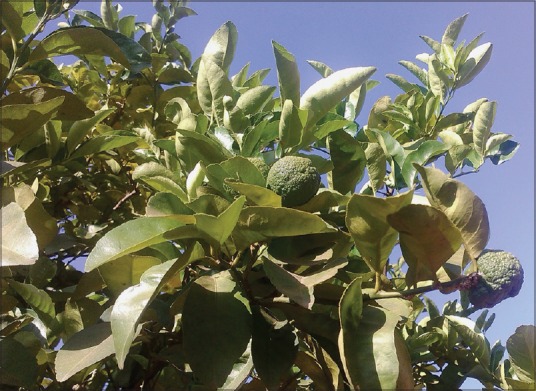
Live plant of Citrus jambhiri Lush.
MATERIALS AND METHODS
Fresh fruit of C. Jambiri, was collected from a local vegetable market of Jamnagar. Botanical identification was done with the help of various floras, and it was authenticated at the Pharmacognosy lab, Institute for Post Graduate Teaching and Research in Ayurveda, Gujarat Ayurveda University, Jamnagar. Organoleptic characters like color, taste, touch and odor were recorded. Thin free hand sections were studied without and with staining (phloroglucinol and concentrated HCl). Powder microscopy of shade-dried powder (#60) was carried out.[8] Photomicrographs were taken using Carl zeiss trinocular microscope attached to camera. Histochemical studies were carried out by taking free hand sections of fruit treated with various reagents, and we found tannin, mucilage, etc.[9] Physicochemical profiling was carried out from shade-dried powder.[10]
RESULTS AND DISCUSSION
Morphology
Fruit, hispiridium 5–10 cm long, ovoid, oblong, globose, nipple shaped at the end with and rough or irregular or warted rind [Figure 2]. Rind was 2–3 cm in thickness, leathery, aromatic and encloses multicarpelled (nearly 9–10) segments or locules. Each locule encloses abundant juice sacs and contains 3–5 seeds; dark green when unripe and yellow when ripe, pulp is pale yellow, taste acidic and sweetish. At the centre of the fruit, there are thick thread-like structures holding carpels forming column [Figure 2a].
Figure 2.
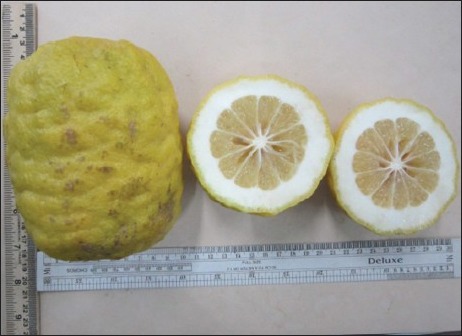
Citrus jambhiri Lush. fruit
Figure 2.
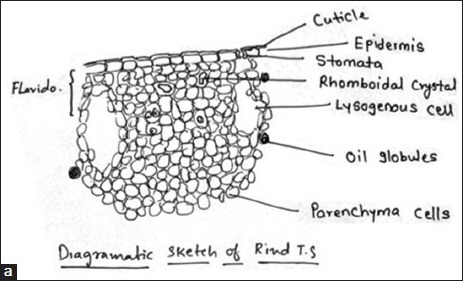
(a) Transverse section of fruit rind
T.S. of fruit
Diagrammatic section of fruit shows outer rind, middle segments and the central axis. Transverse section of rind shows lysogenous cells [Figure 3a] and flavido region [Figure 3b].
Figure 3.
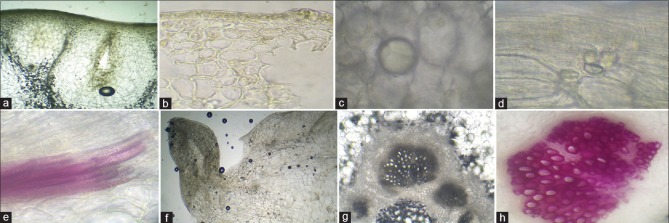
(a) Lysogenous cells, (b) flavido region, (c) oil globules, (d) prismatic crystals of calcium oxalate, (e) annular and scalariform vessels, (f) juicy sac, (g and h) central axis or column
The detailed section shows exocarp, mesocarp and endocarp. Exocarp has outer compactly arranged cells (flavido zone) and inner loosely arranged albido zone. Exocarp consists of single layered rectangular cells with a thin cuticle. Outermost layer of the flavido zone is the single layered epidermis. Some of the epidermal cells are interrupted by stomata. Many layers of thin walled parenchyma cells are present below the epidermis. Many lysogenous cavities are found all over the section with oil globules [Figure 3c]. Some of the parenchyma cells also contain prismatic crystals of calcium oxalate [Figure 3d]. Below the flavido zone, mesocarp with loosely arranged aerenchyma cells forming the network like albido zone. Some of the vascular bundles were distributed in albido zone. Annular and scalariform vessels were also found [Figure 3e].
Each juicy sac [Figure 3f] was made up of outer compactly arranged 10–15 layers of elongated compressed parenchyma cells, while inner loosely arranged parenchyma cells consisted of prismatic crystals.
Central thick thread-like structure called central axis or column was noticed [Figure 3g and h]. It consists of outer single layered barrel-shaped cells and central pith consisting loosely arranged parenchyma cells. Many vascular bundles are distributed all over the pith.
Powder microscopy
Organoleptic characters
Organoleptic characters like color, odor and taste were recorded [Table 1].
Table 1.
Organoleptic characters of powder

Diagnostic characters of powder shows fibers with epidermal cells [Figure 4a], fragments of epicarp cells, fragments of the term has uniformly has been referred as albido [Figure 4b] and flavido [Figure 4c], oil globules [Figure 4d], prismatic crystals of calcium oxalate [Figure 4e], annular vessels, pitted vessels, scalariform vessels [Figure 4f], spiral vessels [Figure 4g], tannin content [Figure 4h], mesocarp cells and fragments of column.
Figure 4.

(a) Fibers with epidermal cells, (b) fragments of albido, (c) fragments of flavido, (d) oil globules, (e) prismatic crystals of calcium oxalate, (f) scalariform vessels, (g) spiral vessels, (h) tannin content
Histochemical evaluation
Thick sections were subjected to various chemical tests, and tannin and lignin etc., were detected [Table 2].
Table 2.
Histochemical evaluation of thick sections
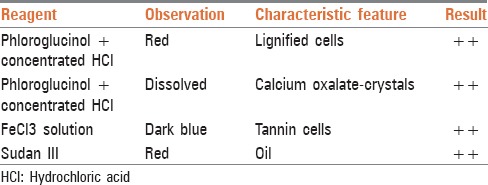
Physicochemical evaluation
Parameters like loss on drying, ash value, water soluble extract, alcohol soluble extract, pH, specific gravity and total solid content were carried out, observed results are summarized at Tables 3 and 4.
Table 3.
Physicochemical evaluation of powder

Table 4.
Particulars of Jambiri Nimbū Swarasa

CONCLUSION
Pharmacognostical study of C. jambhiri Lush. provides specific parameters that will be useful for identification and authentication of the drug. Parenchyma cells, prismatic crystals of calcium oxalate, aerenchyma cells, oil globules, pitted vessels, scalariform vessels, juicy sac, central axis consisting outer single layered barrel-shaped cells and central pith consist loosely arranged parenchyma cells are the prominent characters that distinguish it from other plant species. As no published reports are available on this plant, the results obtained in the current study may be referred as a standard in future studies.
Footnotes
Source of Support: Nil.
Conflict of Interest: None declared.
REFERENCES
- 1.Gupta AK, Sharma M. Vol. 6. New Delhi: ICMR; 2008. Reviews on Indian Medicinal Plants; p. 473. [Google Scholar]
- 2.Vol. 3. New Delhi: Publications and Information Directorate, CSIR; 1992. CSIR. A Dictionary of Indian Raw Materials and Industrial Products, The Wealth of India (Raw Materials) p. 614. [Google Scholar]
- 3.Samal PK, Shah A, Tiwari SC, Agrawal DK. Indigenous healthcare practices and their linkages with bioresource conservation and socio-economic development in Central Himalayan region of India. Indian J Tradit Knowledge. 2004;3:12–26. [Google Scholar]
- 4.Sharma AS. Reprint 2000. 11th ed. New Delhi: Motilala Banarsidas; 2000. Rasa Tarangini, 12/6; p. 285. [Google Scholar]
- 5.Reprint edition 2007. New Delhi: Meherchand Lachamandas Publications; 2007. Vagbhatacharya. Rasaratnasamucchaya, 5/53; p. 101. [Google Scholar]
- 6.Sen GD. Reprint 2011. Varanasi: Chaukhamba Prakashana; 2011. Bhaishajya Ratnavali, Agnimandya Adhikara 93-94; p. 341. [Google Scholar]
- 7.Sastri VL. Reprint edition 2005. Varanasi: Chaukhambha Prakashana; 2005. Yogaratnakara, Vidyotini Hindi Commentary; p. 244. [Google Scholar]
- 8.Kokate CK. Delhi: Vallabh Prakashan; 2003. Practical Pharmacognosy; pp. 28–93. [Google Scholar]
- 9.Krishnamurty KV. Madras: Vishwanadhan Pvt Limited; 1988. Methods in the Plant Histochemistry; pp. 1–77. [Google Scholar]
- 10.Appendix-2. Vol. 3. New Delhi: Govt. of India: Ministry of Health and Family Welfare; 2001. Anonymous. The Ayurvedic Pharmacopoeia of India. Part 1; p. 207. [Google Scholar]


